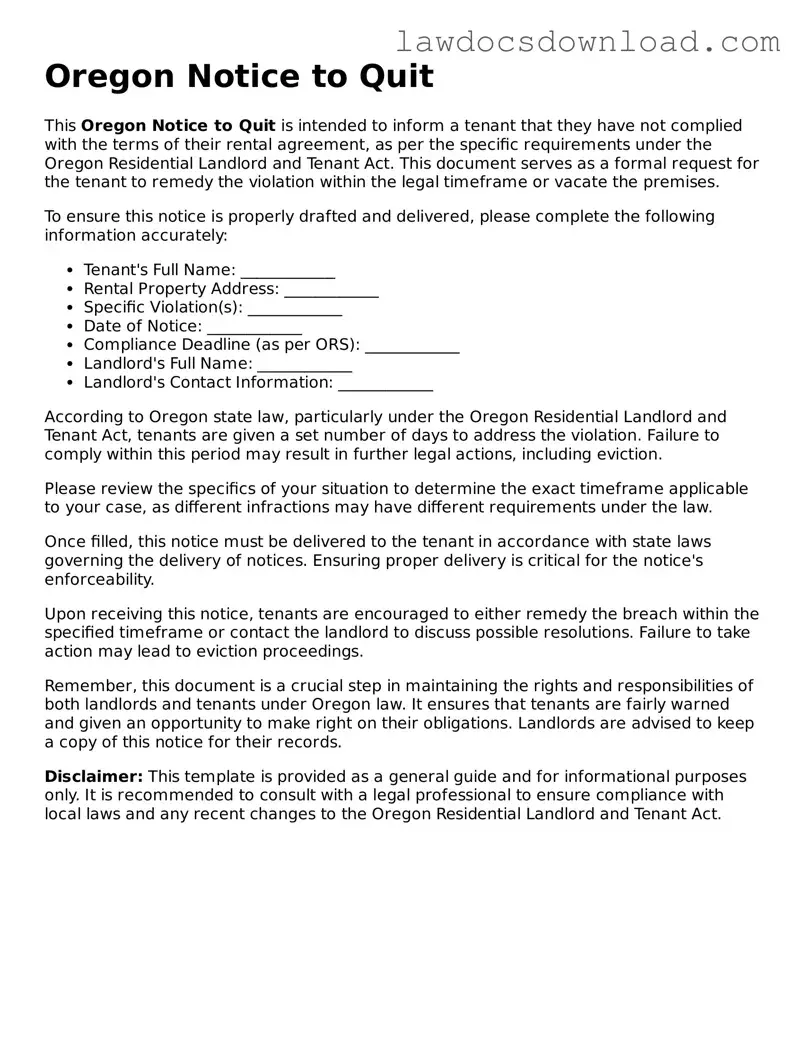The Oregon Notice to Quit is similar to the Pay or Quit Notice found in many states. This document is used by landlords to alert tenants that they must either pay the overdue rent or vacate the premises by a certain date. Both documents serve as a preliminary step before eviction proceedings for non-payment of rent, setting a clear deadline for tenants to remedy the violation to avoid legal action.
Another related document is the Cure or Quit Notice, which, like the Oregon Notice to Quit, is issued when a tenant violates terms of the lease aside from rent payment—such as keeping unauthorized pets, causing damage, or conducting illegal activities on the property. This notice gives the tenant a chance to "cure" the violation, usually by a specified deadline, highlighting the universal approach to lease violations across jurisdictions.
The Eviction Notice, while broader, shares similarities with the Oregon Notice to Quit. It formally advises tenants that legal action will be pursued to remove them from the property. Eviction Notices, which can include Pay or Quit, Cure or Quit, and Unconditional Quit notices, serve as formal steps in the eviction process, aiming to recover possession of the property.
An Unconditional Quit Notice, tougher than the Oregon Notice to Quit, demands that a tenant vacates the property with no chance to pay overdue rent or correct a lease violation. Despite their differences, both notices are used in circumstances where the landlord seeks to terminate the lease agreement, albeit for more severe violations in the case of the Unconditional Quit Notice.
Notice of Lease Violation, similar to the Oregon Notice to Quit, is issued to tenants who break terms of their lease. However, this document often pertains to violations outside of rent payment, and like the Cure or Quit Notice, it allows tenants a chance to rectify the issue within a given timeframe to avoid further action.
The 30-Day Notice to Vacate is akin to the Oregon Notice to Quit in that it is a formal letter from the landlord to the tenant indicating the lease will not be renewed and the tenant must leave the property. Both documents serve the purpose of notifying tenants of the need to move out, though the 30-Day Notice generally applies to end-of-lease situations or month-to-month tenancies without specific lease violations.
A Notice of Rent Increase can be considered similar to the Oregon Notice to Quit because it notifies the tenant of changes to the terms of their lease—specifically, an increase in rent. If tenants choose not to accept the new rent and do not vacate, a Pay or Quit Notice may follow, tying these two types of notices together in the lease management process.
The Lease Renewal Notice, while indicating the continuation rather than the cessation of a tenancy, relates to the Oregon Notice to Quit by addressing the terms under which the tenant can continue to occupy the property. This notice provides options for renewal to the tenant, contrasting with the Notice to Quit's role in lease termination.
The Entry Notice, though different in purpose, shares the premise of notifying tenants of the landlord's intentions, similar to the Oregon Notice to Quit. This notice informs tenants in advance of the landlord's plan to enter the property for inspections, repairs, or showings, demonstrating the legal requirement to respect tenants’ rights and privacy.
Finally, the Abandonment Notice parallels the Oregon Notice to Quit in situations where a tenant unexpectedly vacates a property without notice. While the Notice to Quit is a precursor to potential eviction, an Abandonment Notice is employed post-factum to declare the landlord's intention to reclaim and repossess the property, following a tenant's unexplained absence and failure to pay rent.
